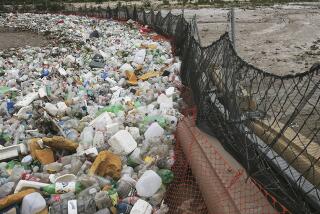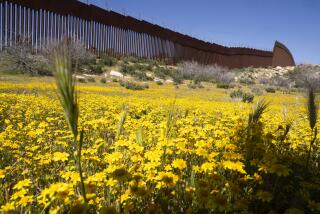U.S., Mexico Act to Meet Environment Crisis on Border : Inter-American affairs: Plan assigns priorities to pollution problems where population has exploded.
- Share via
WASHINGTON — The U.S. and Mexican governments unveiled a broad strategy Thursday that seeks to coordinate their efforts to reduce a growing environmental crisis along their 1,550-mile border.
Although the plan offers little by way of new initiatives or specific goals, it assigns priorities to the pollution problems facing the border region, where population has almost doubled since 1980.
Growth along the border has overtaxed existing sewage facilities and other infrastructure, spawning a host of air and water pollution problems, as well as difficulties in controlling the disposal of toxic materials.
While the border environmental plan is not directly linked to ongoing talks toward establishing a free-trade zone between the two countries, those negotiations have given the document additional political significance.
Thus, officials on both sides of the border are eager to show that they are giving serious thought to the problems.
In releasing the plan Thursday, Environmental Protection Agency Administrator William K. Reilly said: “I don’t think that there has been any previous moment in the history of our two countries when there has been such sustained and intensive and high-level attention to the environmental problems that affect our border.”
In Mexico City, Patricio Chirinos, minister of urban development and ecology, added: “More than a catalogue of works, the plan is a strategy for working together.”
Yet the plan is primarily a recitation of initiatives already under way. “It is a quick reaction to get something down on paper as part of the free-trade agreement,” said Pete Silva, assistant deputy director of San Diego’s Clean Water Program. “EPA really hasn’t had much time to put much meat onto this thing.”
In San Diego’s case, the plan identified the reduction of municipal waste water and air pollution as top priorities. Among the solutions it cited is the San Diego-Tijuana waste water treatment facility, for which the Administration has earmarked $100 million of the $112 million it plans to spend on border pollution next year.
The Administration also is conducting an environmental review that will focus more directly on issues related to free trade, such as pesticide regulation and assuring that the two countries are operating under comparable environmental standards. A draft of that review is expected to be completed by the end of next month.
Opponents contend that the increased economic activity generated by a free-trade agreement inevitably would worsen border pollution and weaken existing U.S. regulations.
Yet the Bush Administration contends that opening up trade would have the opposite result, generating wealth for Mexico that it could invest in cleaning up its environment. “Poverty and environmental improvement do not coexist,” Reilly said.
But even as the Environmental Protection Agency was unveiling the border plan, a coalition of consumer and environmental groups was announcing a lawsuit that seeks to force the Administration to file an environmental impact statement on the effects of a free-trade agreement.
Reilly said that the border plan “goes considerably beyond” an environmental impact statement and added that the Justice Department has determined that no such statement is required under law.
Tumulty reported from Washington and Darling from Mexico City.
More to Read
Sign up for Essential California
The most important California stories and recommendations in your inbox every morning.
You may occasionally receive promotional content from the Los Angeles Times.










